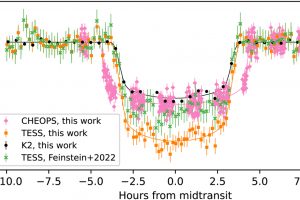A planet with elusive properties for V1298 Tau. The paper: “Photometric follow-up of the 20 Myr old multi-planet host star V1298 Tau with CHEOPS and ground-based telescopes” of M. Damasso (INAF-OATo) appeared on A&A

Among the stars known to host more than one planet, V1298 Tau deserves particular attention. This star, located approximately 360 light years away from us, is around 20 million years old and possesses a planetary system with four exoplanets discovered so far. Due to these characteristics, V1298 Tau can offer valuable insights into the planetary formation process and the early evolution of planetary systems.
For its characteristics, V1298 Tau has been the subject of several studies aimed at characterizing its planetary system. For instance, the properties of V1298 Tau b have been determined with good accuracy. The planet has a mass of 0.64 Jupiter masses and a density similar to that of the gaseous giants in the Solar System and other known old gas planets. However, the properties of the outermost known planet of V1298 Tau (V1298 Tau e) remain elusive. Previous studies, mainly based on data acquired with the NASA satellite Kepler, have allowed the observation of a transit of V1298 Tau e and the measurement of its orbital period (about 40 days) and mass (1.16 Jupiter masses). In this case as well, the density of the planet is similar to the values typically observed in more evolved giant planets. A second transit has been observed with TESS, and it has allowed the determination of the orbital period of 46.8 days.
To determine the physical and orbital properties of V1298 Tau e, the team of researchers led by astronomer M. Damasso (INAF – Astrophysical Observatory of Turin) analyzed new observations of V1298 Tau obtained with the European Space Agency’s CHEOPS satellite (CHaracterising ExOPlanets Satellite). The observations were planned to test three possible values for the orbital period of V1298 Tau e (44.17, 45.00, and 46.77 days), which are the most probable values from the combined analysis of transits observed with TESS and Kepler. CHEOPS observations include a new transit which, if associated with V1298 Tau e, results in an orbital period of about 45 days. Furthermore, this transit is significantly deeper than those observed with TESS and Kepler. Considering these differences with the previous transits, the authors have discussed two possible scenarios. If the third transit is attributed to V1298 Tau e, then the orbital parameters of the planet must not be stable over time. It is also possible that the transit is associated with a fifth planet, whose existence has been suggested by a previous study. The study is detailed in the paper titled “Photometric follow-up of the 20 Myr old multi-planet host star V1298 Tau with CHEOPS and ground-based telescopes”, recently published in Astronomy & Astrophysics. Among the authors are astronomers S. Benatti, A. Maggio, and G. Micela of INAF – Astronomical Observatory of Palermo.
The figure (click here to visualize it entirely) shows the transits due to V1298 Tau e observed by Kepler, TESS, and CHEOPS.
Mario Giuseppe Guarcello ( follow mariospiegacose) ( mariospiegacose) ( follow mariospiegacose)
Follow the Astronomical Observatory of Palermo on Facebok and on Instagram
Subscribe the Youtube channel of the Astronomical Observatory of Palermo
